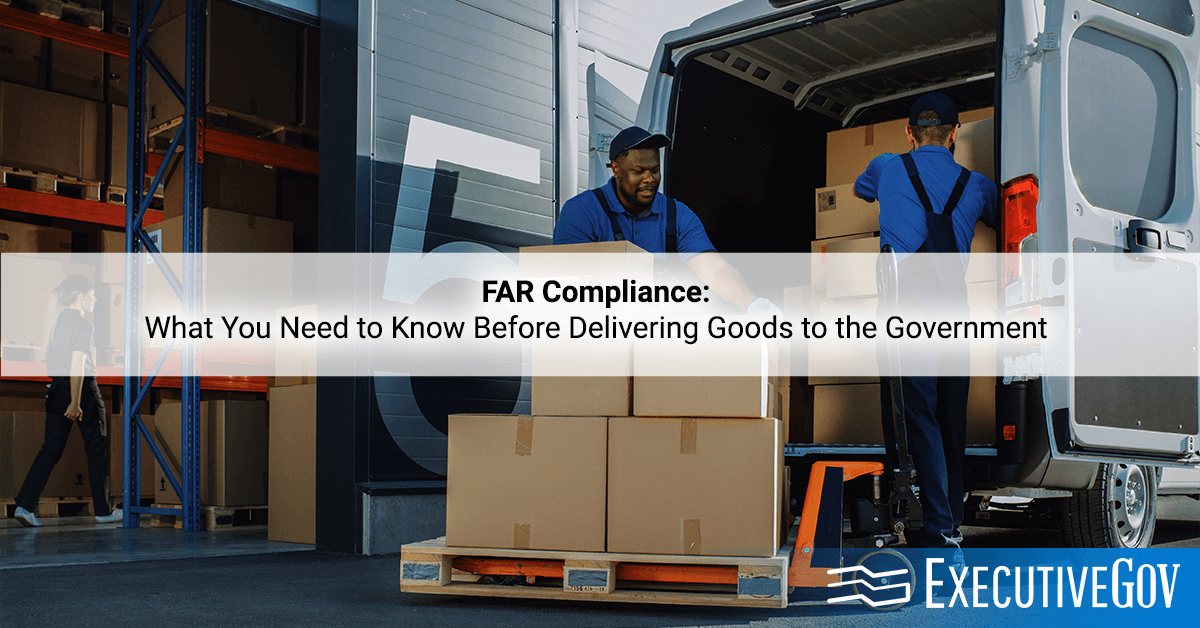FAR compliance is crucial for government contractors to maintain their ties with the federal government. Complying with these regulations allows companies to establish their trades, deliver goods and services and maintain honest and transparent transactions.
If you’re looking to provide services and solutions to the government, read on to learn more about FAR compliance.
Table of Contents
What is FAR?

The Federal Acquisition Regulation (FAR) is the primary set of regulations encompassing all government procurement aspects of executive agencies. It was formed through the Office of Federal Procurement Policy Act of 1974, which created a standard for acquiring goods and services for federal agencies in the executive branch.
FAR ensures the delivery of top-caliber products and services while maintaining public trust and fulfilling public policy objectives.
As stated in section 1.102, the main goals of FAR are to:
(1) Satisfy the customer in terms of cost, quality and timeliness of the delivered product or service by, for example –
(i) Maximizing the use of commercial products and commercial services
(ii) Contracting with companies who have a track record of successful past performance or who have demonstrated the ability to perform
(iii) Promoting competition
(2) Minimize administrative operating costs
(3) Conduct business with integrity, fairness and openness
(4) Fulfill public policy objectives
Simply put, FAR compliance is a manual that government contractors must follow to deliver goods and services to federal agencies. It outlines what contractors can and can not charge in a federal contract.
FAR Compliance Components: Where to Start?

Reading and understanding all eight subchapters and 53 parts of the FAR can be daunting, but there’s a handful of components that fledgling contractors can begin with.
Outlined below are the key parts to help you get started in FAR compliance:
FAR Part 31 – Contract Cost Principles and Procedures
FAR Part 31 defines the procedures and principles involving contracting costs, such as establishing reasonableness, determining allocability and accounting for unallowable costs.
FAR Part 52 – Solicitation Provisions and Contract Clauses
FAR Part 52 covers the clauses and provisions on allowable costs and payments, including:
- Reimbursement
- Direct labor
- Invoicing
- Travel expenses
- Bill payments
- Warranties
- Termination
- Supplies and services
- Indirect expenses
FAR Part 15 – Contracting by Negotiation
FAR Part 15 establishes the policies and processes for contract negotiations. It guides agencies in preparing proposals and contracts.
At the same time, it gives contractors an estimate of how long a contract negotiation takes to determine the final costs and pricing. It can help contractors gauge their submissions to agencies accordingly.
FAR Part 17 – Special Contracting Methods
FAR Part 17 encompasses specialized contracting arrangements, such as options, leader company and multi-year contracting. Multi-year contracts aim to lower costs, ensure production continuity, stabilize contractor workforces and reduce the administrative burden of contracts.
Moreover, FAR Part 17 clarifies the multi-year agreement requirements for the DoD, NASA and the Coast Guard, including:
- Substantial cost savings
- Unchanged procurement needs
- Stable supply designs
- Reasonable funding expectations
- Realistic cost estimates
FAR Part 19 – Small Business Programs
FAR Part 19 covers many elements related to small businesses, including participation through HUBZone, service-disabled veteran-owned, women-owned small businesses (WOSB) and economically disadvantaged women-owned small businesses (EDWOSB).
Additionally, section 19.202-1 promotes the involvement of small businesses in acquisitions and ensures equal opportunity to compete for federal contracts.
FAR Part 36 – Construction and Architect-Engineer Contracts
FAR Part 36 delves into the contracting procedures and policies for construction and architect-engineer services. It sheds light on standard form requirements and clauses for demolition, dismantling or removal of improvements.
Other Components to Consider
Besides the six essential FAR components, contractors also need to consider provisions for labor standards, intellectual property rights and other clauses.
Here are other FAR clauses to consider:
Termination for Convenience
This clause allows the government to end a contract at any time for any reason. While it gives the government flexibility in its procurement process, it poses a risk for contractors if they’ve already invested time and resources into fulfilling the contract’s orders.
Changes
Under this provision, the government is allowed to change the contract’s terms and conditions. That said, contractors must be prepared to adapt to these adjustments, whether small or drastic, to fulfill their end of the agreement.
Disputes
This clause defines the protocols for resolving disagreements between the government and contractor. It’s designed to promote fairness and transparency in the contracting process.
Small Business Subcontracting
Under this clause, large contractors are required to include smaller businesses in their subcontracting plan. It promotes small business participation in the government contracting process.
The Davis-Bacon Act
The Davis-Bacon and Related Acts oversee prevailing wages, regulations and standards that federal agencies must observe. This provision protects workers from being underpaid and prevents contractors from gaining an unfair advantage.
Frequently Asked Questions
What Are the Different Types of FAR Contracts?
The six types of contracts governed by the Federal Acquisition Regulation are:
- Fixed-price
- Cost-reimbursement
- Incentive
- Indefinite-delivery (requirements, definite-quantity and indefinite-quantity)
- Agreements (basic and basic ordering)
- Time-and-materials, labor-hour and letter
Does FAR Apply to All Government Agencies?
No, it doesn’t. FAR only applies to contracts awarded by agencies within the executive branch, such as the DOD, DOJ and VA.
Contracts from the legislative and judicial branches are subject to separate regulations.
What is DFARS?
FAR and DFARS may look and sound familiar, but they differ greatly in how they’re used.
Any contracting entity working on a federal contract is subject to FAR compliance. Meanwhile, only entities working with Controlled Unclassified Information (CUI) must comply with the Defense Federal Acquisition Regulation Supplement.
Additionally, DFARS is a supplement to FAR; contractors must still comply with FAR when working on contracts from the DoD.
You might also want to read: Beginner’s Guide to Becoming a Government Contractor





